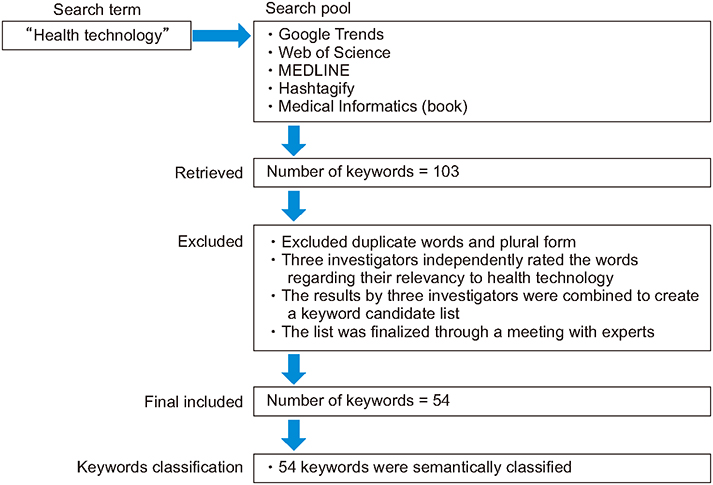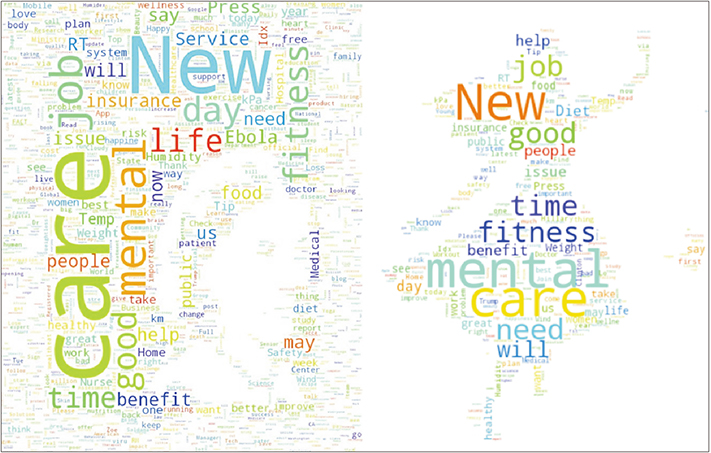Healthc Inform Res.
2019 Apr;25(2):99-105. 10.4258/hir.2019.25.2.99.
Health Information Technology Trends in Social Media: Using Twitter Data
- Affiliations
-
- 1Department of Nursing Science, College of Life & Health Sciences, Hoseo University, Asan, Korea.
- 2College of Nursing, Seoul National University, Seoul, Korea. leehyeongsuk@snu.ac.kr
- 3Research Institute of Nursing Science, Seoul National University, Seoul, Korea.
- 4Medical Intensive Care Unit, Samsung Medical Center, Seoul, Korea.
- KMID: 2445006
- DOI: http://doi.org/10.4258/hir.2019.25.2.99
Abstract
OBJECTIVES
This study analyzed the health technology trends and sentiments of users using Twitter data in an attempt to examine the public's opinions and identify their needs.
METHODS
Twitter data related to health technology, from January 2010 to October 2016, were collected. An ontology related to health technology was developed. Frequently occurring keywords were analyzed and visualized with the word cloud technique. The keywords were then reclassified and analyzed using the developed ontology and sentiment dictionary. Python and the R program were used for crawling, natural language processing, and sentiment analysis.
RESULTS
In the developed ontology, the keywords are divided into "˜health technology"˜ and "˜health information"˜. Under health technology, there are are six subcategories, namely, health technology, wearable technology, biotechnology, mobile health, medical technology, and telemedicine. Under health information, there are four subcategories, namely, health information, privacy, clinical informatics, and consumer health informatics. The number of tweets about health technology has consistently increased since 2010; the number of posts in 2014 was double that in 2010, which was about 150 thousand posts. Posts about mHealth accounted for the majority, and the dominant words were "˜care"˜, "˜new"˜, "˜mental"˜, and "˜fitness"˜. Sentiment analysis by subcategory showed that most of the posts in nearly all subcategories had a positive tone with a positive score.
CONCLUSIONS
Interests in mHealth have risen recently, and consequently, posts about mHealth were the most frequent. Examining social media users' responses to new health technology can be a useful method to understand the trends in rapidly evolving fields.
Keyword
MeSH Terms
Figure
Cited by 1 articles
-
Keyword Trends for Mother–Child Oral Health in Korea Based on Social Media Big Data from Naver
Jung-Eun Park, Ja-Won Cho, Jong-Hwa Jang
Healthc Inform Res. 2020;26(3):212-219. doi: 10.4258/hir.2020.26.3.212.
Reference
-
1. Denecke K, Nejdl W. How valuable is medical social media data? Content analysis of the medical web. Inform Sci. 2009; 179(12):1870–1880.
Article2. Lober WB, Flowers JL. Consumer empowerment in health care amid the internet and social media. Semin Oncol Nurs. 2011; 27(3):169–182.
Article3. Lee KH. A study on the introduction of Twitter according to its application types. Korean Corp Manage Rev. 2011; 37(1):279–297.4. Kwak HW, Lee CH, Park HS, Moon SB. Is Twitter social network? From the perspective of the network structure and information propagation. J Commun Res. 2011; 48(1):87–113.
Article5. Chew C, Eysenbach G. Pandemics in the age of Twitter: content analysis of Tweets during the 2009 H1N1 outbreak. PLoS One. 2010; 5(11):e14118.
Article6. Gohil S, Vuik S, Darzi A. Sentiment analysis of health care tweets: review of the methods used. JMIR Public Health Surveill. 2018; 4(2):e43.
Article7. Nawaz MS, Bilal M, Lali MI, Ul Mustafa R, Aslam W, Jajja S. Effectiveness of social media data in healthcare communication. J Med Imaging Health Inform. 2007; 7(6):1365–1371.
Article8. Fisher J, Clayton M. Who gives a tweet: assessing patients' interest in the use of social media for health care. Worldviews Evid Based Nurs. 2012; 9(2):100–108.
Article9. Gupta A, Tyagi M, Sharma D. Use of social media marketing in healthcare. J Health Manag. 2013; 15(2):293–302.
Article10. Klischewski R. Top-down or bottom-up? How to establish a common ground for semantic interoperability within e-government communities. In : Proceedings of 1st International Workshop on E-Government at ICAIL; 2003 Jun 24; Edinburgh, Scotland. p. 17–26.11. Hashtagify [Internet]. [place unknown]: Hashtagify;c2019. cited at 2019 Feb 14. Available from: https://hashtagify.me/.12. Hoyt RE, Sutton M, Yoshihashi A. Medical informatics: practical guide for the healthcare professional. 3rd ed. Morrisville (NC): Lulu Press Inc.;2009.13. Esuli A, Sebastiani F. Sentiwordnet: a publicly available lexical resource for opinion mining. In : Proceedings of the 5th Conference on Language Resources and Evaluation; 2006 May 24–26; Genoa, Italy. p. 417–422.14. Nakov P, Ritter A, Rosenthal S, Sebastiani F, Stoyanov V. SemEval-2016 Task 4: sentiment analysis in Twitter. In : Proceedings of the 10th International Workshop on Semantic Evaluation; 2016 Jun 16–17; San Diego, CA. p. 1–18.15. Annau M. Online sentiment analysis using R [Internet]. Wien, Austria: Vienna University of Economics and Business;2010. cited at 2019 Mar 24. Available from: http://statmath.wu.ac.at/courses/SNLP/Presentations/DA-Sentiment.pdf.16. Silva BM, Rodrigues JJ, de la Torre Diez I, Lopez-Coronado M, Saleem K. Mobile-health: a review of current state in 2015. J Biomed Inform. 2015; 56:265–272.
Article17. Dolan B. Report: 13K iPhone consumer health apps in 2012 [Internet]. [place unknown]: MobiHealthNews;2012. cited at 2019 Feb 14. Available from https://www.mobihealthnews.com/13368/report-13k-iphone-consumer-health-apps-in-2012.18. Aitken M, Gauntlett C. Patient apps for improved healthcare: from novelty to mainstream. Parsippany (NJ): IMS Institut e for Healthcare Informatics;2013.19. Fedele DA, Cushing CC, Fritz A, Amaro CM, Ortega A. Mobile health interventions for improving health outcomes in youth: a meta-analysis. JAMA Pediatr. 2017; 171(5):461–469.
Article20. Larsen-Cooper E, Bancroft E, Rajagopal S, O'Toole M, Levin A. Scale matters: a cost-outcome analysis of an m-Health intervention in Malawi. Telemed J E Health. 2016; 22(4):317–324.
Article21. Neufeld JD, Doarn CR, Aly R. State policies influence medicare telemedicine utilization. Telemed J E Health. 2016; 22(1):70–74.
Article22. Oh JY, Park YT, Jo EC, Kim SM. Current status and progress of telemedicine in Korea and other countries. Healthc Inform Res. 2015; 21(4):239–243.
Article23. Khan MT, Khalid S. Sentiment analysis for health care. Int J Priv Health Inf Manag. 2015; 3(2):676–689.
Article24. Palomino M, Taylor T, Goker A, Isaacs J, Warber S. The online dissemination of nature-health concepts: lessons from sentiment analysis of social media relating to “Nature-Deficit Disorder”. Int J Environ Res Public Health. 2016; 13(1):E142.
Article25. Cohen JE. What privacy is for. Harv Law Rev. 2013; 126:1904–1933.26. Gantz J, Reinsel D. The digital universe in 2020: big data, bigger digital shadows, and biggest growth in the far east [Internet]. Hopkinton (MA): EMC Corp.;2012. cited at 2019 Apr 1. Available from: https://www.emc.com/collateral/analyst-reports/idc-the-digital-universe-in-2020.pdf.27. Charbonneau DH. Privacy practices of health social networking sites: implications for privacy and data security in online cancer communities. Comput Inform Nurs. 2016; 34(8):355–359.
- Full Text Links
- Actions
-
Cited
- CITED
-
- Close
- Share
- Similar articles
-
- A proof-of-concept study of extracting patient histories for rare/intractable diseases from social media
- Social Media Mining Toolkit (SMMT)
- An empirical evaluation of electronic annotation tools for Twitter data
- Health and Social Media: Perfect Storm of Information
- The social media footprint of endoscopic spine surgery: a cross-sectional analysis of content on Twitter/X




